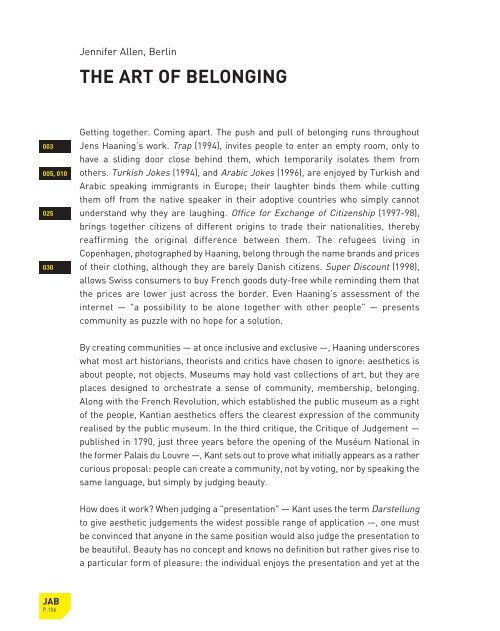download catalogue high resolution pdf (22.3 mb) - Jens Haaning
download catalogue high resolution pdf (22.3 mb) - Jens Haaning
download catalogue high resolution pdf (22.3 mb) - Jens Haaning
You also want an ePaper? Increase the reach of your titles
YUMPU automatically turns print PDFs into web optimized ePapers that Google loves.
003<br />
005, 010<br />
025<br />
030<br />
JAB<br />
P.106<br />
Jennifer Allen, Berlin<br />
THE ART OF BELONGING<br />
Getting together. Coming apart. The push and pull of belonging runs throughout<br />
<strong>Jens</strong> <strong>Haaning</strong>’s work. Trap (1994), invites people to enter an empty room, only to<br />
have a sliding door close behind them, which temporarily isolates them from<br />
others. Turkish Jokes (1994), and Arabic Jokes (1996), are enjoyed by Turkish and<br />
Arabic speaking immigrants in Europe; their laughter binds them while cutting<br />
them off from the native speaker in their adoptive countries who simply cannot<br />
understand why they are laughing. Office for Exchange of Citizenship (1997-98),<br />
brings together citizens of different origins to trade their nationalities, thereby<br />
reaffirming the original difference between them. The refugees living in<br />
Copenhagen, photographed by <strong>Haaning</strong>, belong through the name brands and prices<br />
of their clothing, although they are barely Danish citizens. Super Discount (1998),<br />
allows Swiss consumers to buy French goods duty-free while reminding them that<br />
the prices are lower just across the border. Even <strong>Haaning</strong>’s assessment of the<br />
internet — "a possibility to be alone together with other people" — presents<br />
community as puzzle with no hope for a solution.<br />
By creating communities — at once inclusive and exclusive —, <strong>Haaning</strong> underscores<br />
what most art historians, theorists and critics have chosen to ignore: aesthetics is<br />
about people, not objects. Museums may hold vast collections of art, but they are<br />
places designed to orchestrate a sense of community, me<strong>mb</strong>ership, belonging.<br />
Along with the French Revolution, which established the public museum as a right<br />
of the people, Kantian aesthetics offers the clearest expression of the community<br />
realised by the public museum. In the third critique, the Critique of Judgement —<br />
published in 1790, just three years before the opening of the Muséum National in<br />
the former Palais du Louvre —, Kant sets out to prove what initially appears as a rather<br />
curious proposal: people can create a community, not by voting, nor by speaking the<br />
same language, but simply by judging beauty.<br />
How does it work? When judging a "presentation" — Kant uses the term Darstellung<br />
to give aesthetic judgements the widest possible range of application —, one must<br />
be convinced that anyone in the same position would also judge the presentation to<br />
be beautiful. Beauty has no concept and knows no definition but rather gives rise to<br />
a particular form of pleasure: the individual enjoys the presentation and yet at the


